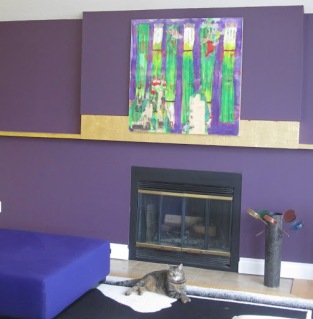 |
| A new painting about…guess what? |
 |
| Luckily for me, the hockey bag doesn’t reek. |
 |
| A new painting about…guess what? |
 |
| Luckily for me, the hockey bag doesn’t reek. |
 |
| “Our house, is a very, very, very fine house; with two cats in the yard… |
 |
| My neat studio, a rare occurrence |
However there are still a lot of people who are Crawl virgins, or who would like advice on getting more out of their Crawl experience, so here’s some advice. Of course, you may wonder how someone who sits in her studio during the Crawl can even give advice on how to tour…so I have also gotten help from an expert. Liz Malinka has been doing the Crawl for over ten years now, she is both an art lover and an art collector. In fact, she and her husband, Frank, both love the Crawl so much that they became financial supporters of the event.
 |
| Michelle Sirois-Silver in her studio |
Here’s some lovely advice from Liz, “Lastly, have fun, talk to the artists! It will add to the whole experience if you are able to connect with them and get to know a little bit about them. Who knows, perhaps friendships will develop, it’s happened to me many times! “
When I was a child, I used to go to the home of a graphic designer who had her studio in the basement. I loved to wander downstairs and look at her papers, her pristine white drawing table and best of all her markers, perfectly lined up in the full rainbow of colours. Seeing ALL the colours in perfect order gives me an enormous thrill to this day. And that is why I love going into the studio of textile artist, Michelle Sirois-Silver.
 |
| These fabric stacks are my favourite things in her studio, the textile equivalent of a paintbox. |
I first met Michelle when she moved into the shared studio across the hall from my studio, and then followed her into her studio in the basement of her home, and then I helped her link up with her current studio. I’ve been wanting to take photographs of Michelle’s studio ever since I saw her first studio, and now with the Culture Crawl on the horizon, I can feature this lovely spot and anyone can visit it as well.
 |
| Michelle, hard at work. |
 |
| The old and the new. |
 |
| A little sampler which I found quite beautiful. |
What is one thing that really inspires your creativity?
var _gaq = _gaq || []; _gaq.push([‘_setAccount’, ‘UA-7668080-3’]); _gaq.push([‘_trackPageview’]); (function() { var ga = document.createElement(‘script’); ga.type = ‘text/javascript’; ga.async = true; ga.src = (‘https:’ == document.location.protocol ? ‘https://ssl’ : ‘http://www’) + ‘.google-analytics.com/ga.js’; var s = document.getElementsByTagName(‘script’)[0]; s.parentNode.insertBefore(ga, s); })();
 |
| One of the plants in the new garden is appropriately called Black Magic |
I am fascinated by other people’s studios. I love poking around and seeing how artists organize things and how the studio reflects the work. So as part of an occasional series in my blog, I would like to introduce artist’s studios that I find interesting.
Lisa Ochowycz is an abstract painter that I met when she was sitting outside my studio one early summer morning, waiting to sign a lease for a new studio space in my building. She looked so friendly and we hit it off right away, and now that I have moved upstairs my studio is right across the hall from her. I must admit, I was pretty surprised when I first saw her studio. Her paintings are complete abstractions, with large areas of floating colour, drippy shapes, and soft transitions of form. But her studio is divinely organized, and as a naturally messy person I am very impressed. Anyway, take a look for yourself. Here is Lisa’s studio, and her poetic answers to my nosy questions.
What is your favourite part of the studio?
Firstly, I love the building I am in and the variety of artists I am surrounded by. As for the studio itself, it’s wonderful to have a place that really feels like my own; being tucked away up in the mezzanine, with lots of light, my painting wall, a small selection of teas, and a little tapenade and fresh bread….it all adds up to providing a great deal of artists legroom. I feel so fortunate to have this space.
Can you tell me about your studio routine?
As an abstract expressionist it’s become apparent that each element of my day is related to my time in the studio. Friendships, family, biking to my studio, chai at Granville Island, they’re all precursors that set the stage for what can happen when I’m in front of a blank panel. Once I’ve arrived at my studio I prefer to start my time with writing a bit in my journal it’s an effortless way to achieve a general focus and clarity. By the time the first brush strokes are made I’m clear and feel in tune and I don’t feel overshadowed by whatever stresses may have accumulated during the day.
What is one thing that really inspires your creativity?
Acquiring a depth of understanding in life is the greatest muse I’ve come across, and few things promote it more than music.
To see more of Lisa’s work, please check out her website.